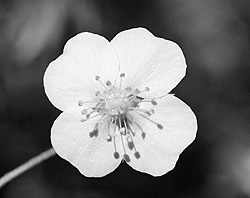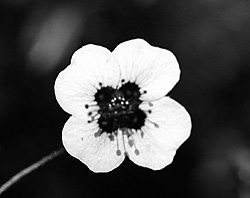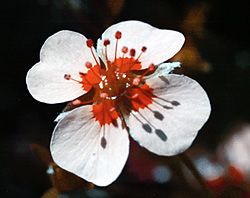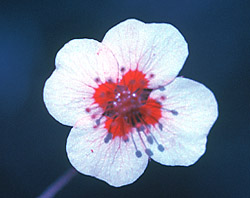| All You Ever Wanted to Know About Digital UV and IR Photography, But Could Not Afford to Ask | |
| All You Ever Wanted to Know About Digital UV and IR Photography, But Could Not Afford to Ask | |
3. Can a digital camera capture UV images, just like a film-based system?
Few people have tried using ultra-violet approaches with their digital cameras. Perhaps not surprising, as UV photography is considered a highly exotic task even for the film-based crowd. My foray into digital UV was initiated because of my scientific interest in the hidden UV-markings of many flowers. In fact, that interest led to my purchasing the UV-Nikkor lens back in 1992, just for taking images showing flowers the way bees would see them. Bees, of course, have a UV-enhanced vision and Nature prudently has made flowers and bees co-operate to fulfil their mutual interests. Flowers need to be pollinated, and bees need to get food. UV-visible marks on the petals do the advertising job for the flowers and direct the pollinators towards their ultimate reward, the nectar and pollen of the flowers.
People sometimes claim they obtain "UV" images with their digital cameras, but just slapping on a UV bandpass filter will by itself not guarantee true UV images are recorded. To ensure this, the taking lens must pass sufficient of UV, and the digital sensor must be sensitive to UV as well. The advantage of using flowers for UV photography is that you can ascertain the method works as you'd expect. If the known floral patterns emerge, then you can be assured the recorded response stems from UV. I have verified earlier that b/w digital UV images are identical to those obtained by film. The panel below shows evidence that digital UV colour is similar to the film-based picture, given the appropriate equipment is used.
| Take a closer look here of these
comparison images of cinquefoil (Potentilla
erecta) shot a few minutes apart,
using my UV-Nikkor 105 mm f/4.5 lens on film (Nikon F5)
or digital (Nikon D1X) cameras. This yellow-flowered
species, like so many others in the Rose family, exhibits
strong UV patterns on the petals.
These floral marks are displayed similarly by digital and
film records. |
|
 |
 |
B/W: Visible light Ilford
XP2 film |
B/W: UV light Ilford
XP2 film |
 |
 |
Digital: UV light |
Film: UV light |
| Digital
@ 200 ISO Nikon FF filter Tiffen Hot Mirror filter SB-140 flash with SW5-UV filter |
Fuji
RTP-II film @64 ISO Nikon FF filter SB-140 flash with SW5-UV filter |
|
| Another
test for UV photography is using a sunscreening lotion to
cover a face partially. You should get a clear-cut
pattern, because a decent lotion effectively absorbs UV Nikon
D70, UV-Nikkor 105 mm f/4.5, Hoya-U-360 filter |
Again, as in the case of
digital IR, we obtain strangely coloured images directly from the
camera. Typically these have a strong pinkish or yellowish red
cast, and are frequently low in contrast. Some cameras
yield deep blue images instead. I tend to see them as a kind of
"negatives" waiting to be processed, like a colour film
negative with its strong orange mask. I normally do a
"click-white" operation in Bibble for files from D1H or
D1X, while D1 files are better served by Nikon Capture 2. My D2H
and D70 files are processed in Nikon Capture 4.x which seems to
struggle a bit colour-balancing these NEFs, but getting a
pleasant end result is doable albeit not entirely
straight-forward. The new Bibble 4.0 copes much better with UV images and has largely
taken over as my standard software for this application.
|
| Shot in
b/w, digital UV expectedly shows the landscape softened
by a strong haze. The ground and foliage are darkish
due to low UV reflectance, while water is bright because
the surface reflects a good deal of UV (incidentally,
that's why we get tanned or sunburned on the beach). The
sky is washed out in the UV shot. Compare this image with
the corresponding b/w digital IR to get better
insight in the ways these ranges of the spectrum differ. Nikon
D1, UV-Nikkor 105 mm f/4.5, Hoya-U-360 filter |
Exposures for digital UV photography are often handled well by the camera itself, just as we found for digital IR. However, take extreme care to ensure that no stray light can enter through the camera's ocular. Use the eye-piece shutter to guard against this, or if your camera lacks such feature, cover the ocular by your hand or black cloth. Since the UV levels are much lower than ordinary light, the metering system is guaranteed to be thrown out of whack unless you take these precautions.
Some cameras, in particular Nikon D100, needs a substantial +EV correction to be dialed in as well. Similar to the IR case, you should check that the LCD histogram displays really useful information. If the CCD records little in the green channel for the UV pictures, the histogram will indicate a severe underexposure, while in fact the image may be properly exposed for UV. You have to examine the entire RGB-histogram in a suitable computer program (Bibble, Nikon Capture, Adobe Photoshop etc.) to make sure your exposures are spot on.
Compared with visual-light shooting, you can expect any kind of UV photography to give from 6 up to 15 stops longer exposures, so by necessity a tripod should be used. The apparent loss of film/digital sensitivity is largely caused by UV intensity itself being so much lower than visible light levels, but a further loss occur due to lens and the recording media (film or digital sensors). With my UV-Nikkor lens, I find the digital UV correction to range from +4 to +6.5 EV, which in fact is quite similar to that of film-based UV photography. However, for non-quartz lenses you would expect quite higher correction factors than this. Stacking the UV bandpass filter(s) with a hot-mirror filter also gives a penalty measured in a higher factor, thus typically 1- 2 EV should be added.
One might end up with excessively long exposures, so digital noise is likely degrading the images. If your camera has a noise-reduction feature, ensure it is switched on before shooting UV.